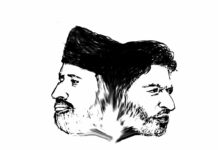Muhammad Tahir
 When political closure gave rise to the Kashmiri armed militancy in the late 1980s, the autonomous political process was suspended momentarily by the complexities of the militant phase; yet in January 1993 a common forum was founded in the shape of All Parties Hurriyat Conference (APHC). APHC was a broad alliance of some 30 political and socio-religious organizations represented in a General Council while the main seven political groups formed an Executive Council.
When political closure gave rise to the Kashmiri armed militancy in the late 1980s, the autonomous political process was suspended momentarily by the complexities of the militant phase; yet in January 1993 a common forum was founded in the shape of All Parties Hurriyat Conference (APHC). APHC was a broad alliance of some 30 political and socio-religious organizations represented in a General Council while the main seven political groups formed an Executive Council.
How these leaders “re-positioned” the political process was to make the Kashmiri pro-resistance groups eschew their differing ideological projections and instead present a common minimum program in terms of maintaining a united stand on the right to self-determination.
APHC, however, faced a split in the year 2003 when Hurriyat patriarch Syed Geelani accused that some APHC members had had fielded “proxy candidates” in assembly elections (election boycott was an accepted principle among all the members). Syed Ali Geelani, who represented Jama’at-e-Islami at that time, started working independent of what forms Hurriyat (M) now; he later on formed a separate political forum called Tehreek-e-Hurriyat (TeH). Masarat Alam (ideologically closer to Geelani) joined it in 2007.
Over the years Tehreek-e-Hurriyat emerged as a relatively credible group in the eyes of general public in Kashmir because of the ‘steadfastness’ of its patron on the position of right to self-determination and its apparent Islamist orientation; and on the other side, APHC’s (M) pragmatist approach and the secret parleys with the state come to be seen with increasing suspicion.
Thus, as John Cockell argues, “there is significant flux in the dynamics of nationalist mobilization, with political formations first gaining popular legitimacy and then losing it to new formations as they become compromised by their engagement with the state and its dominant discourses”.
That is why Sajjad Lone, son of late Abdul Gani Lone, was accused of harming the “freedom struggle” when he decided to contest elections.
Then there are leaders like Azam Inquilabi, Shakeel Bakhshi, Shabir Shah, Nayeem Khan, Ghulam Qadir Wani et al who remained entrenched in the mainstream of the ethno-political strain of the Kashmiri resistance movement both ideologically as well as in their political positions, allowing them to retain some credibility among the people and be able to represent politically on the basis of their long association and contributions to Tehreek. As early as 1994, Shabir Shah had appealed for the “dissolution of all political parties” to have a common stand. Interestingly, in 2014 Shabir Shah along with some other members came up with the third Hurriyat and called it the true one.
Therefore, we can say these developments marked the elements of “discontinuities” in Kashmiri national movement in terms of faction splits, political repositions, and ideological clashes. What weakens the position and credibility of political formations is the growing perception among the people that the movement ‘suffers’ from dissensions and cannot effectively represent us and in extension, has fewer chances to negotiate successfully with the state on their behalf (Cockell). This is what ultimately transpired in the case of Kashmir national movement. People grew wary of APHC leaders and lost confidence in them.
However, 2008 -2010 mass protests allowed the pro-resistance leaders to re-establish themselves as the ‘guardians’ of Kashmiri national movement. The scene and intensity of the protests and discontentment between 2008 and 2010 changed the political discourse about Kashmir so much so that pro-India parties in Kashmir were forced to emphasize that elections had nothing to do with the Kashmir conflict and they even appropriated the resistance discourse to stay relevant in Kashmiri politics and be seen as ‘pro-Kashmir’.
(The author is a research scholar at Dublin City University, Ireland.)















